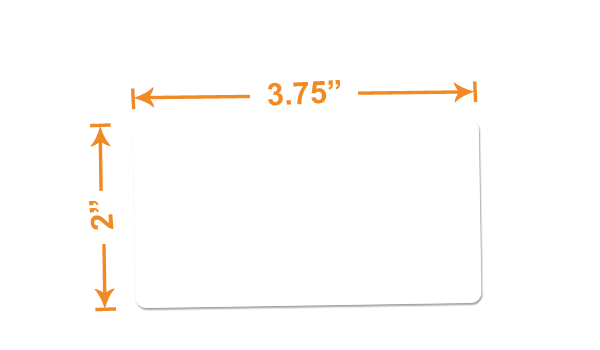Just How Blank Labels Can Streamline Your Company and Personalized Classifying Tasks
In today's fast-paced environment, effective company is crucial, and empty tags use a flexible service that can enhance your custom-made labeling jobs. These labels not just supply versatility in shapes and size yet likewise enable a customized strategy that satisfies specific business requirements. By decreasing reliance on pre-printed alternatives, you can promote efficiency and sustainability in your labeling techniques. The advantages prolong past simple convenience; comprehending the various means empty labels can change your processes is crucial for maximizing their potential. What innovative applications could you discover with this easy yet effective tool?
Advantages of Using Blank Labels
Using empty labels provides many benefits for company and efficiency in different settings. One substantial advantage is the ability to customize labels according to certain demands, which boosts clarity and availability. This modification is specifically valuable in environments such as offices, storehouses, and homes, where exact recognition of things is crucial for smooth operations.
Moreover, blank labels can significantly decrease time invested in labeling tasks (Blank Labels). Instead of counting on pre-printed labels that may not accurately reflect current inventory or project requirements, customers can quickly design and publish tags as required. This versatility lessens waste and advertises a much more sustainable method to labeling
The cost-effectiveness of empty tags can not be overlooked; they offer a budget-friendly remedy for businesses and individuals alike, guaranteeing that identifying demands are met without sustaining unnecessary expenses. In summary, the advantages of making use of blank tags prolong beyond plain ease, providing significant improvements in efficiency and organization.

Kinds of Space Labels Available
When checking out the different types of empty tags readily available, it's necessary to consider the varied materials and formats that accommodate different applications. Blank tags can be classified into several essential types, each made for certain uses and environments.
Paper labels are commonly utilized because of their price and convenience. They are appropriate for indoor applications, such as filing systems, product labeling, and company tasks. For outdoor or high-moisture atmospheres, plastic labels provide sturdiness and resistance to water, making them excellent for classifying containers, outdoor equipment, and signs.
Another prominent choice is thermal transfer labels, which work with thermal printers. These labels are optimal for shipping and inventory administration, as they supply high-grade prints that withstand wear and tear. Furthermore, specialty tags, such as those with removable glue or static stick, offer one-of-a-kind objectives, enabling momentary labeling without leaving residue.
Last but not least, tag sheets and rolls can be found in numerous shapes and sizes, accommodating various printers and applications. Recognizing these kinds of empty labels allows users to pick the most effective options for their business needs, improving efficiency and clearness in identifying tasks.
Personalization Options for Labels
Tag customization uses customers the opportunity to tailor their labeling remedies to meet certain requirements and choices. This versatility is important for enhancing organization and ensuring that each tag offers its intended function effectively.
One of the main customization choices is the shapes and size of the labels. Users can select from a variety of measurements to fit various containers, folders, or surface areas. In addition, the product of the go to this web-site label-- such as paper, vinyl, or polyester-- can be chosen based upon durability requirements and ecological problems.
Color is another essential facet of customization. Users can pick details shades to match branding or to produce an aesthetic coding system that assists in quick recognition. Message and graphic alternatives permit for tailored messages, logos, or symbols, making certain that labels convey the essential info plainly and wonderfully.
Practical Applications for Everyday Use

In the office, empty labels offer a myriad of features. Blank tags can likewise be used for supply monitoring, enabling businesses to track supply levels and simplify buying processes.
Educational settings profit significantly from empty tags as well. Educators can use them to classify class click here to find out more materials, creating an organized atmosphere helpful to finding out. Pupils can label personal items to stop mix-ups, advertising duty and liability
In addition, throughout events or celebrations, blank tags can aid in organizing name tags, food things, and materials, ensuring a smooth experience for participants. Generally, the versatility of blank tags makes them an indispensable device for enhancing company throughout different day-to-day applications.
Tips for Effective Labeling Jobs
Effective labeling jobs call for careful planning and interest to information to maximize their organizational advantages. To start, define the goals of your labeling task clearly. Determine what things require labeling and the particular info each tag must communicate. This will certainly simplify your design process and make certain relevance.
Following, select the suitable label type and material based on the atmosphere and period of usage. Waterproof labels are perfect for outside applications, while removable labels work well for temporary organization.
Layout your tags with quality in mind. Blank Labels. Usage understandable typefaces, contrasting shades, and straightforward graphics to boost readability. Uniformity in label size and formatting additionally adds to a natural feel and look
During the application phase, ensure surface areas are tidy and completely dry to promote adhesion. Arrange tags rationally, grouping comparable products together to increase performance.
Last but not least, examine the performance of your labeling system occasionally. Solicit comments from users and make adjustments as necessary. By employing these strategies, you can develop a labeling system that not only enhances company however likewise improves total efficiency and ease of access.
Conclusion
